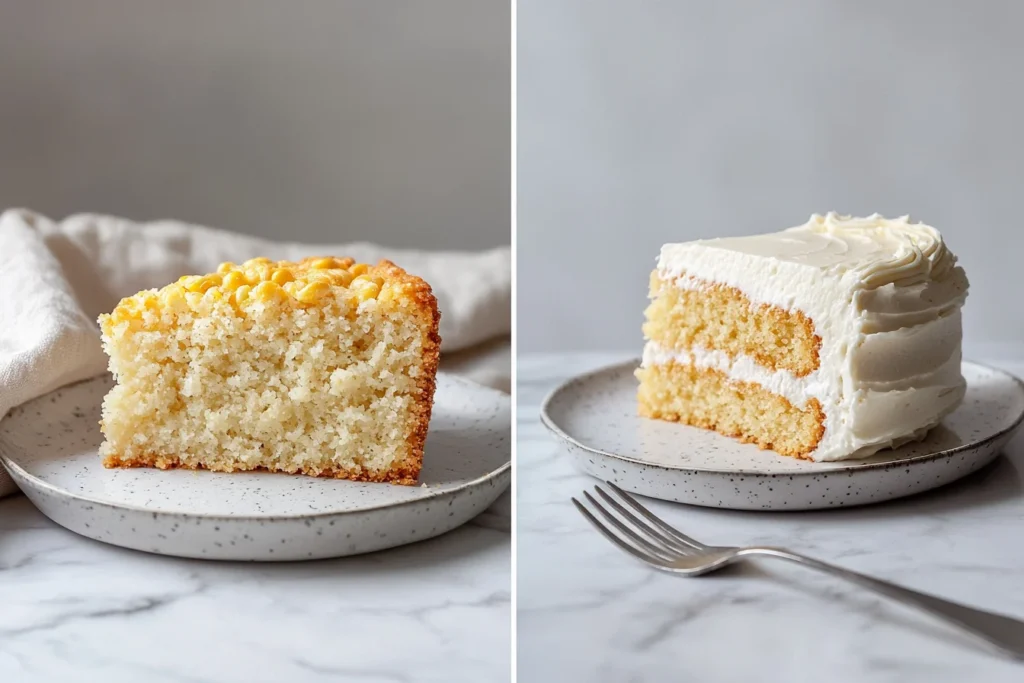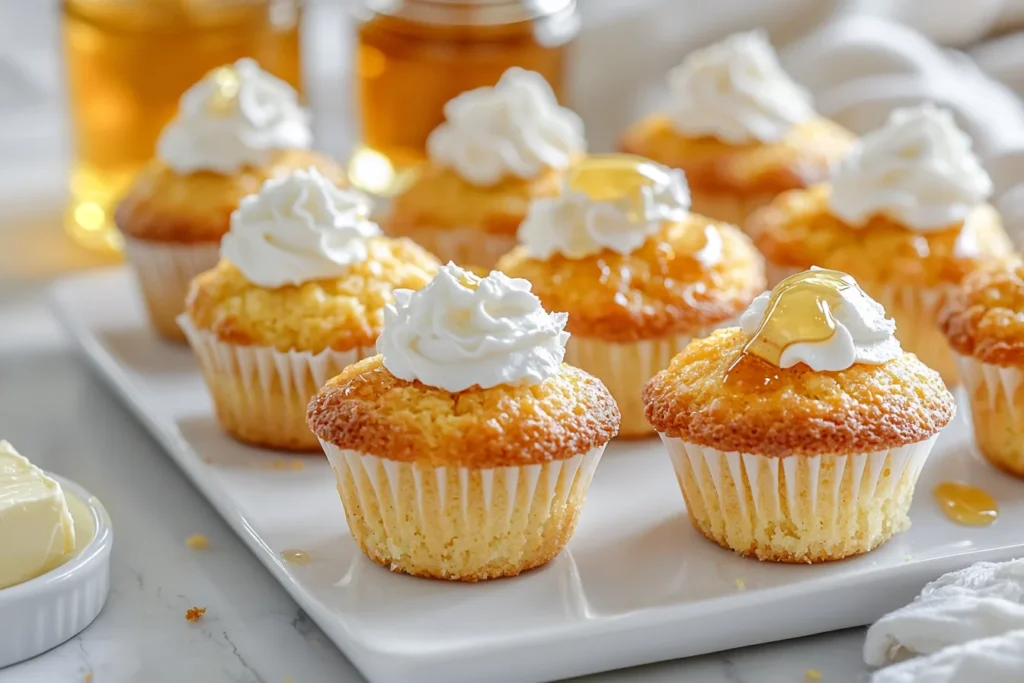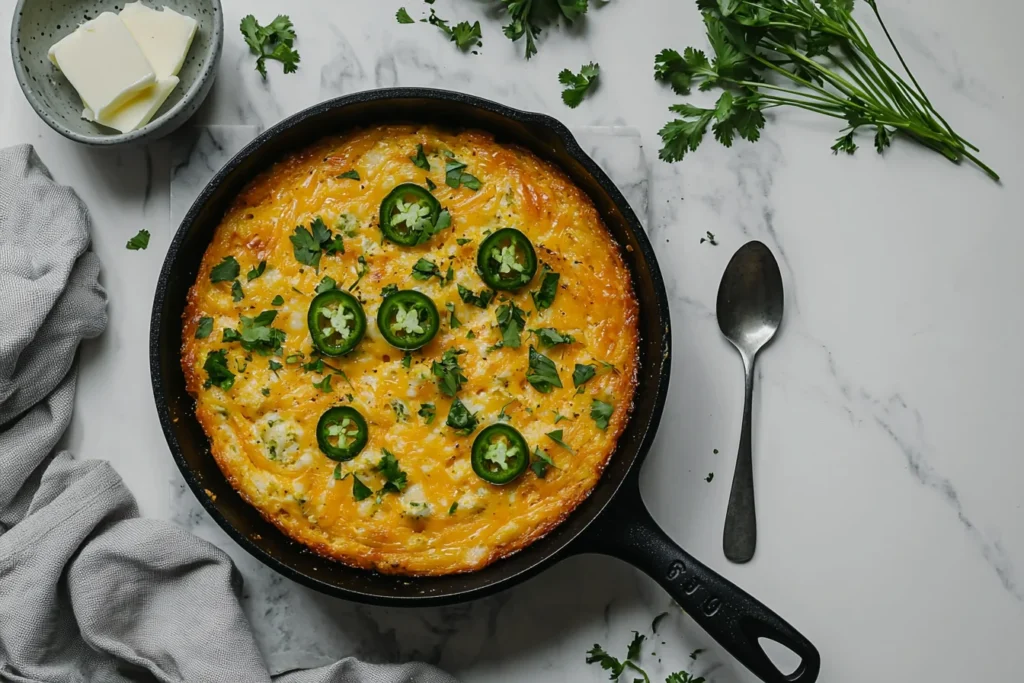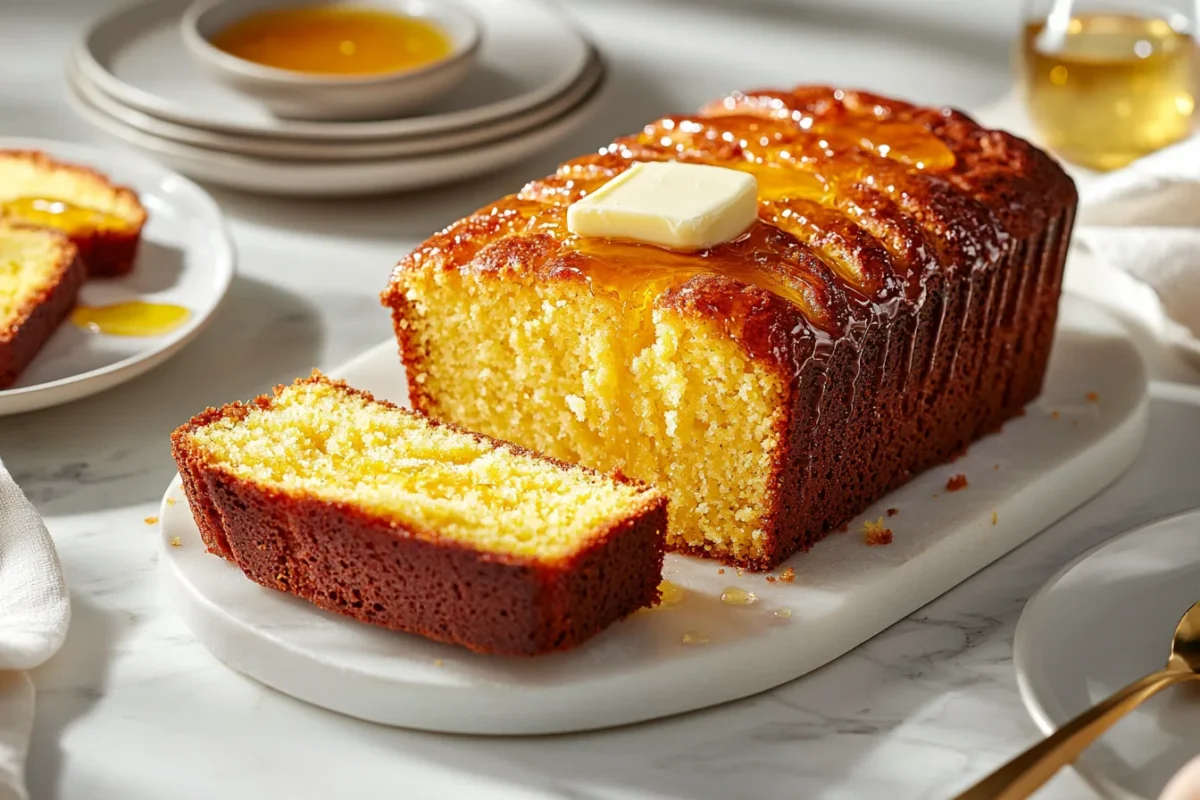Is cornbread like a cake? It’s a question that has sparked curiosity and debate among food lovers. Some say yes because of its moist texture and sweetness, while others insist it’s a bread through and through. First, let’s agree that cornbread is an absolute favorite—simple to make, satisfying to eat, and loved by many.
Next, the beauty of cornbread lies in its versatility. It’s perfect as a savory side dish or a sweet treat, making it a must-have for every meal. Also, it’s quick to prepare and uses everyday ingredients, so you can whip it up without much effort. For more creative ways to enjoy this classic, explore Creative Cornbread Recipes.
If you’ve ever wondered about the similarities between cornbread and cake, you’re in the right place. Keep reading to uncover their differences, shared qualities, and why both deserve a spot on your table. What’s your take? Let us know your favorite way to enjoy cornbread in the comments below!
Table of Contents
The Origins of Cornbread and Cake: Shared History or Separate Paths?
The Historical Roots of Cornbread in Different Cultures
Cornbread has a rich history rooted in indigenous cultures, particularly among Native Americans. First, they used ground corn to create simple bread-like dishes cooked over open fires. This staple food provided nourishment and versatility, and it eventually spread through trade and colonization. Then, early settlers in the Americas adopted cornbread recipes, blending them with European influences. Over time, it became a staple in Southern cooking, cherished for its simplicity and adaptability.
Next, cornbread evolved into many regional variations, each reflecting the local ingredients and cooking styles of its creators. For instance, some recipes included milk or buttermilk, while others added sugar for a touch of sweetness. For a unique twist on tradition, try Cornbread Chocolate Cake, a fun blend of rustic flavors and indulgent sweetness. To learn more about corn’s impact on agriculture and its diverse uses, visit the USDA Agricultural Research Service. Today, cornbread remains a beloved dish, symbolizing comfort and tradition. Its deep cultural roots remind us of its humble beginnings and how it continues to bring people together across generations.
How Cake Evolved as a Distinct Culinary Tradition
Cake’s origins are quite different from cornbread’s, with roots in ancient Egypt and early European traditions. Unlike cornbread, cakes were originally luxury items, made with honey and later refined sugar. First, they were reserved for celebrations and special occasions due to their labor-intensive preparation and costly ingredients.
Then, with the industrial revolution, advancements in baking techniques and ingredient availability made cakes more accessible. Recipes became diverse, ranging from simple pound cakes to elaborate layered desserts. Cake transformed into a universal symbol of joy, often associated with birthdays, weddings, and holidays.
In addition, the use of leavening agents like baking powder gave cakes their signature light and airy texture, differentiating them from denser breads like cornbread. While their histories differ, both cornbread and cake reflect the culinary creativity of their cultures.
Texture and Taste: What Sets Cornbread Apart from Cake?
The Unique Crumb Structure of Cornbread

Cornbread’s texture is one of its defining features. First, its crumb is coarser and denser than cake, giving it a heartier bite. This is largely due to the use of cornmeal, which adds a gritty, rustic feel that sets cornbread apart. Unlike cake, which relies on refined flour for softness, cornbread celebrates its rough edges and robust structure.
Next, cornbread typically has a slightly crumbly nature, making it perfect for soaking up soups, stews, or honey. It balances firmness and moisture, creating a satisfying mouthfeel that’s both comforting and versatile. In addition, the type of cornmeal used can influence the texture, from finely ground for smoother results to coarser grinds for added crunch. Whether baked in a skillet or muffin tin, cornbread’s texture makes it a standout dish that bridges the gap between bread and cake.
Sweetness Levels: Where Cornbread and Cake Differ
When it comes to sweetness, cornbread and cake couldn’t be more different. Cake is known for its sugary sweetness, which is often intensified by rich frostings, glazes, or decorative toppings. Cornbread, on the other hand, varies in sweetness depending on the recipe. First, traditional Southern cornbread leans savory, with minimal sugar to highlight the natural flavor of cornmeal.
Next, other versions, like Northern-style cornbread, include more sugar, giving it a sweeter, cake-like quality. Even then, cornbread never reaches the sweetness of a classic cake.

To dive deeper into how regions influence cornbread recipes, check out Regional Cornbread Variations. In addition, cornbread’s sweetness often complements savory ingredients like cheese or jalapeños, making it a versatile dish. This contrast in sweetness is a key factor in the debate: Is cornbread like a cake? While both can be sweet, their flavor profiles remain uniquely their own and loved by different palates.
Common Ingredients in Cornbread and Cake: Are They the Same?
How Flour and Cornmeal Define the Difference
The key difference between cornbread and cake lies in their base ingredients. First, cornbread uses cornmeal as its primary component, giving it a distinct texture and flavor.

Cornmeal provides a grainy feel, which sets it apart from the smooth and soft texture of cake made with refined flour.
Next, the type of flour used in cake creates a delicate and airy structure. All-purpose or cake flour is finely milled to produce a light crumb, which is perfect for desserts. In addition, cornbread sometimes combines cornmeal with a small amount of flour to create balance, but the corn flavor always shines through. This foundational distinction is what defines cornbread’s rustic appeal versus cake’s refined sweetness. Both recipes showcase their unique traits through their primary ingredients, but their differences ensure they remain separate culinary icons.
The Role of Sugar, Butter, and Eggs in Both Recipes
Sugar, butter, and eggs play an essential role in cornbread and cake, but their quantities vary. First, cake recipes typically call for larger amounts of sugar to create their signature sweetness and decadent appeal. Butter is also used generously to add richness, making each bite smooth, moist, and indulgent.
Next, cornbread uses these ingredients more sparingly, maintaining its simpler, less sweet nature. For instance, Southern cornbread recipes often reduce or omit sugar entirely, letting the corn’s natural flavor shine through beautifully. In addition, eggs in cornbread serve to bind the ingredients together, while in cake, they help achieve a fluffy texture. Butter in cornbread, when used, adds a hint of creaminess without overpowering the dish. These shared ingredients highlight how cornbread and cake differ in purpose, one emphasizing simplicity and the other indulgence, showcasing their unique charm.
Cultural Perspectives on Cornbread and Cake
Regional Variations in Cornbread Recipes
Cornbread takes on many forms across different regions, reflecting the cultural preferences of each area. First, in the Southern United States, cornbread is often savory, featuring minimal sugar and a rich buttery flavor. It’s commonly baked in a cast-iron skillet, creating a golden, crispy crust.
Next, Northern-style cornbread leans sweeter, with more sugar and a softer texture. Some recipes even include honey for extra flavor. In addition, indigenous cultures used cornbread as a staple food, making it with simple ingredients like cornmeal and water. Variations also appear in global cuisines, such as Mexican cornbread with jalapeños and cheese or Caribbean cornbread with coconut. These regional adaptations highlight cornbread’s versatility and its ability to reflect local flavors. Whether sweet or savory, cornbread connects people through its unique taste and adaptability to cultural traditions.
The Role of Cake in Global Celebrations
Cake holds a special place in celebrations worldwide, symbolizing joy and indulgence. First, it’s the centerpiece at birthdays, weddings, and anniversaries, where it represents milestones and shared happiness. Each culture has its own twist on cake, from elaborate multi-tiered designs to simple, rustic creations.
Next, cakes are often infused with local flavors, such as matcha in Japan, almonds in France, or tropical fruits in the Caribbean. These additions make cakes deeply personal and reflective of cultural identity. In addition, traditional cakes like Italian panettone or German stollen are staples during holidays, highlighting the role of cake in family and community traditions. This global love for cake contrasts with cornbread’s simpler roots, yet both share the ability to bring people together. The comparison shows how food can unite us while celebrating cultural diversity.
Modern Twists: Cornbread Cakes and Cake-Like Cornbread
Hybrid Recipes That Blur the Lines
Modern recipes often blur the lines between cornbread and cake, creating delightful hybrids. First, sweet cornbread recipes add ingredients like honey, maple syrup, or brown sugar, making them closer to a dessert than a side dish. These recipes have a softer, more cake-like texture, perfect for those who love a sweet treat with an innovative twist.
Next, bakers have begun experimenting with layers, adding frosting or creamy fillings to transform cornbread into a show-stopping dessert. In addition, hybrid recipes sometimes include fruits like blueberries, cranberries, or even citrus zest, combining the natural sweetness of fruit with the rustic charm of cornbread. These creative twists offer a unique way to enjoy a familiar favorite while exploring its potential as a dessert or special occasion treat. By blending elements of cornbread and cake, these recipes appeal to anyone who enjoys innovation in the kitchen and loves unexpected flavors.
Creative Additions That Transform Traditional Cornbread
Cornbread’s simplicity makes it a blank canvas for creative additions, taking it beyond its traditional role.

First, savory add-ins like jalapeños, cheddar cheese, or bacon add bold flavors that complement the cornmeal base beautifully. These versions are ideal for pairing with chili, soups, or barbecue dishes, creating a balanced, flavorful combination.
Next, sweet versions include ingredients like cinnamon, nutmeg, or even chocolate chips, giving cornbread a dessert-like twist that surprises and delights. Some recipes swap buttermilk for coconut milk or almond milk, creating a subtle yet distinctive flavor profile. In addition, modern bakers experiment with gluten-free or vegan options, using alternative ingredients to make cornbread accessible to a wider audience with specific dietary needs. These creative additions highlight cornbread’s versatility, allowing it to evolve into a more diverse dish while maintaining its comforting, traditional essence loved by many.
Is Cornbread Like a Cake? The Verdict from Experts and Enthusiasts
What Professional Chefs Say About the Comparison
Professional chefs often have strong opinions when it comes to the cornbread-versus-cake debate. Many agree that while both share some common ingredients, their purposes and preparation methods set them apart. Chefs frequently highlight cornbread’s rustic appeal, noting its versatility as a side dish or savory accompaniment. Its texture, often coarse and crumbly, makes it ideal for pairing with soups, stews, or hearty dishes.
Cake, in contrast, is seen as a sweet indulgence meant to be celebrated. Chefs emphasize the role of sugar, butter, and refined flour in creating cake’s soft and airy texture. They also point out that cornbread’s natural corn flavor makes it a distinct dish, not easily mistaken for cake. Ultimately, chefs celebrate cornbread for its simplicity and cake for its decadence, agreeing that both have their own special place in the culinary world.
Popular Opinions from Home Cooks and Food Lovers
Home cooks and food lovers often bring their own experiences to the cornbread-versus-cake discussion. For many, cornbread represents comfort and nostalgia, reminding them of family meals and regional traditions. It is beloved for its simplicity, whether enjoyed plain, with butter, or as part of a savory dish. Sweet variations, like honey cornbread, often blur the lines, adding to the debate.
Food enthusiasts also note how cake brings joy to celebrations and gatherings. Its soft texture and sweetness are associated with birthdays, weddings, and holidays. Many agree that cornbread and cake cater to different moments. Cornbread feels earthy and homey, while cake is all about indulgence. Interestingly, hybrid recipes like cornbread cakes have become a popular way to enjoy elements of both, sparking even more love for these dishes. Both sides of the debate reflect how food brings people together in delightful ways.
Frequently Asked Questions (FAQs)
Is cornbread considered a dessert?
Cornbread is typically not considered a dessert, but it can be sweetened for a dessert-like twist. Traditional cornbread recipes are savory, with minimal sugar, making them a perfect side dish for meals like chili or barbecue. However, some variations include extra sugar, honey, or maple syrup, creating a sweeter version.
In certain regions, sweet cornbread is served as a dessert, especially when paired with butter or jam. It all depends on the recipe and how it’s enjoyed. Whether savory or sweet, cornbread’s versatility makes it perfect for any occasion.
How would you describe the taste of cornbread?
Cornbread has a unique taste that blends savory and sweet flavors depending on the recipe. Traditional cornbread highlights the natural nuttiness of cornmeal, offering a slightly earthy and rich flavor. The savory version pairs beautifully with buttery or cheesy additions, making it perfect for hearty meals.
Sweeter variations add sugar or honey, giving cornbread a mild sweetness similar to a lightly sweetened cake. Its crumbly, soft texture complements its flavor, creating a comforting bite. Cornbread’s taste is simple yet satisfying, making it a favorite across many cuisines.
Are corn cake and cornbread the same?
Corn cake and cornbread share similar ingredients, but they are not the same. Cornbread has a crumbly texture and is often savory, making it a side dish for meals like soups or stews. Corn cake, on the other hand, is sweeter and has a softer, more cake-like texture.
The main difference lies in the sugar content and preparation method. Corn cake typically includes more sugar and may even have a denser consistency due to additional butter or milk. While both use cornmeal as a base, their distinct flavors and textures set them apart.
Can cornbread be made gluten-free?
Cornbread can easily be made gluten-free by using alternative flours. Traditional cornbread recipes typically combine cornmeal with all-purpose flour, but you can substitute gluten-free flours like almond flour, rice flour, or a gluten-free all-purpose blend.
Next, ensure your cornmeal is labeled gluten-free, as cross-contamination can occur during processing. Gluten-free versions maintain their flavor while offering a suitable option for those with dietary restrictions. In addition, adding ingredients like yogurt or buttermilk can enhance the moistness of gluten-free cornbread. With the right tweaks, anyone can enjoy this classic dish.
Cornbread vs. Cake: Celebrate the Best of Both Worlds
Cornbread and cake may share some ingredients, but their differences make them truly special. With its rustic charm and versatility, cornbread often becomes the go-to choice for savory dishes or as a delightful snack. Cake, on the other hand, offers indulgent sweetness and airy textures that are perfect for celebrations.
First, consider cornbread’s adaptability in savory dishes or as a delightful snack. Then, think about cake’s role as a centerpiece for parties and milestones. Both bring joy but cater to different occasions. In addition, creative recipes, like hybrid cornbread cakes, allow you to enjoy the best of both worlds.
Ultimately, the question “Is cornbread like a cake?” depends on how you make it and how you enjoy it. Why not embrace the delicious possibilities both offer? Try your favorite recipes today, and don’t forget to share your thoughts in the comments below—we’d love to hear from you!

